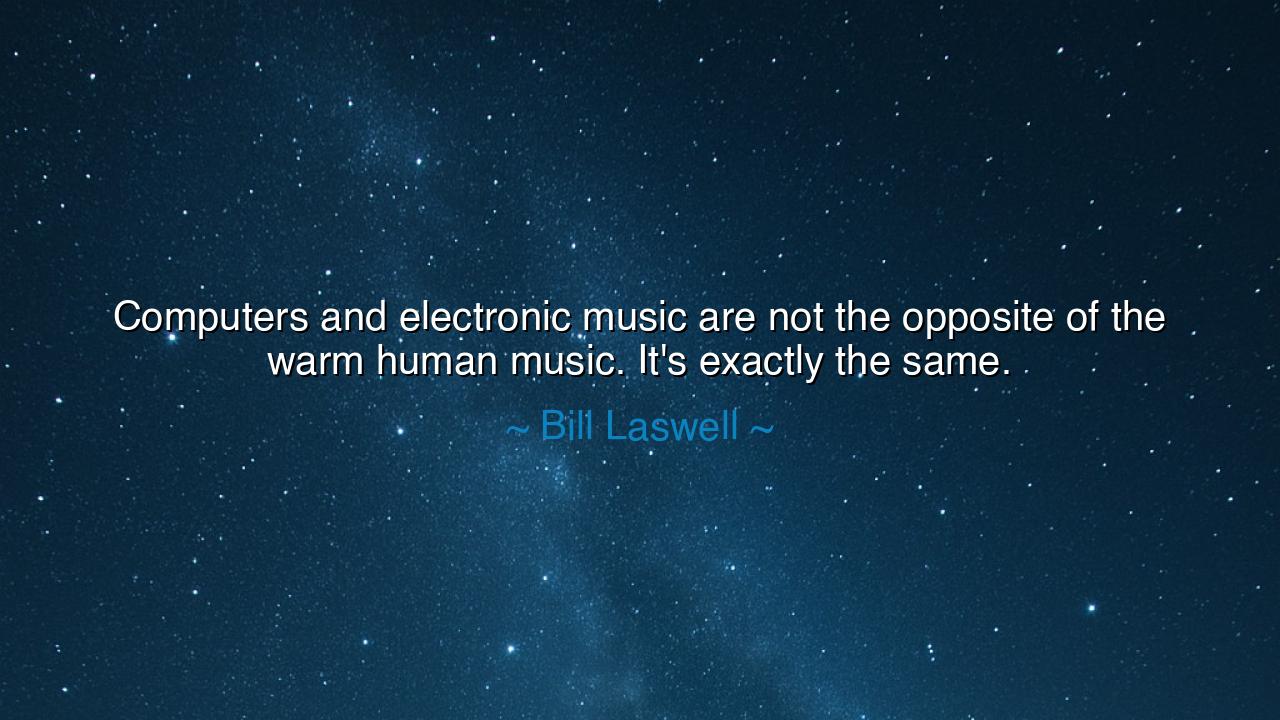
Computers and electronic music are not the opposite of the warm
Computers and electronic music are not the opposite of the warm human music. It's exactly the same.






In the heart of every human being lies the music of the soul—a rhythm, a pulse, a beat that transcends time and space. It is a sound born of humanity, of joy, sorrow, love, and loss, woven into the very fabric of our existence. Yet, as we journey through the ever-advancing world, we find that the tools of creation have evolved. The quote from Bill Laswell, "Computers and electronic music are not the opposite of the warm human music. It's exactly the same," carries within it a profound truth. It speaks to the unity between humanity and technology, between the organic sounds of the heart and the synthesized notes of machines.
The ancient world knew well the power of music to stir the soul. The Greeks believed that music was a divine force, capable of both shaping and reflecting the human spirit. Pythagoras, in his wisdom, taught that the harmony of the cosmos could be understood through the mathematics of sound. Music, he believed, was not merely a human endeavor but a reflection of the very order of the universe itself. Thus, the idea that electronic music—created by the seemingly cold, mechanical hands of computers—could share the same essence as the ancient, warm music played on human instruments might seem a paradox. Yet Laswell’s words remind us that, beneath the surface, all music, whether crafted by human hands or machines, springs from the same deep well of human expression.
Indeed, electronic music—a creation of our modern age—may seem at odds with the tradition of the human-made instrument, with its wooden bodies and strings, its metal pipes and skins. But when one listens closely, the synthesized beats, the whirring electronics, and the digital tones reveal their own beauty. Just as the lute of an ancient bard or the drums of a tribal gathering echo the heartbeats of those who play them, so too do the beats of the computer. The human touch is not absent in electronic music—it is woven through the very creation of these sounds, for every key press, every note, is the product of a mind and a soul who seeks to communicate through the medium at hand.
Consider the story of Beethoven, whose compositions, though borne from the limitations of his time, still transcend the human condition. In his later years, when deafness began to steal his hearing, Beethoven could no longer hear the music he once played, yet he continued to compose the most heroic and moving works known to mankind. His Fifth Symphony, for example, speaks of triumph over adversity, the struggle of the human spirit against overwhelming odds. In this, Beethoven's music was not merely a set of notes—it was the embodiment of human emotion, a reflection of his inner world. So too, electronic music does not stand in opposition to human emotion but mirrors it in new and evolving forms. It is a reflection of our age, an age where technology and humanity are inseparable.
The ancient philosophers, like Aristotle, spoke of the power of art—of its ability to capture the essence of the human experience. Art was not confined to the brush or the chisel but extended to the sounds that reverberate through the air. Laswell’s insight brings us back to this ancient truth: the medium of creation may change, but the soul that creates it remains the same. Music, whether generated by strings or circuits, is still the voice of the human spirit. It is a medium for expression, for connection, for communication. Thus, the warmth of music is not in the material from which it is made but in the heart that beats within it.
The lesson, then, is one of understanding and embracing change. The world may present us with new tools and new ways of creation, but they do not replace the core of what makes us human. Technology—whether in the form of a computer, a synthesizer, or a smartphone—is not the enemy of the soul but the medium through which our inner voices can be heard. Just as artists of old used the materials available to them to craft their masterpieces, so too must we use the tools of our age to express our truths, our passions, and our dreams. There is no need to choose between the old and the new. Both are part of the same story, both are part of the same journey.
In practical terms, let us embrace both the warmth of the human-crafted and the innovation of the digital. When we create, let us remember that expression is not bound by the form, but by the spirit with which we create it. Whether we find ourselves playing a wooden guitar or programming a synth, let us recognize that the human element resides in both. The challenge, then, is not to resist change, but to harness it, to find within the new forms of creation a path that leads to deeper connection with ourselves and with others. Let us make music—whether with our hands, our minds, or our machines—and in doing so, let us continue to speak the language of the soul, across all ages.






AAdministratorAdministrator
Welcome, honored guests. Please leave a comment, we will respond soon